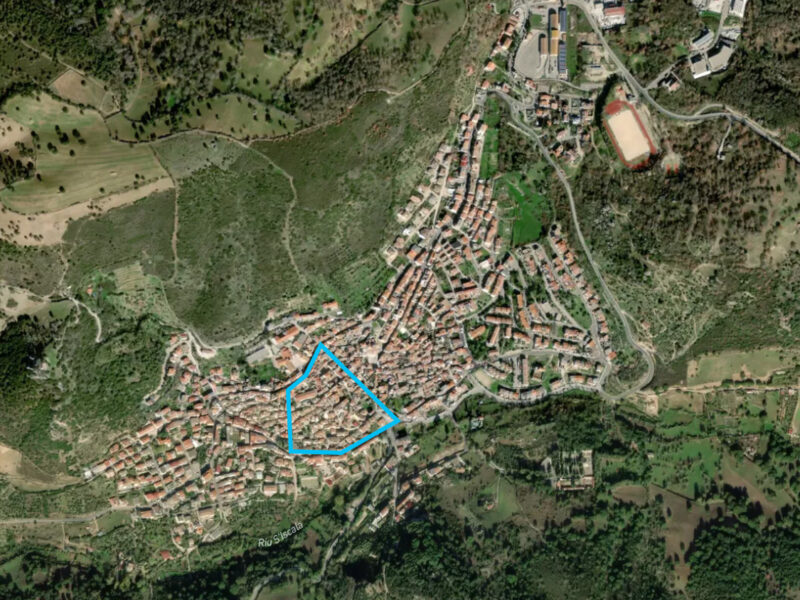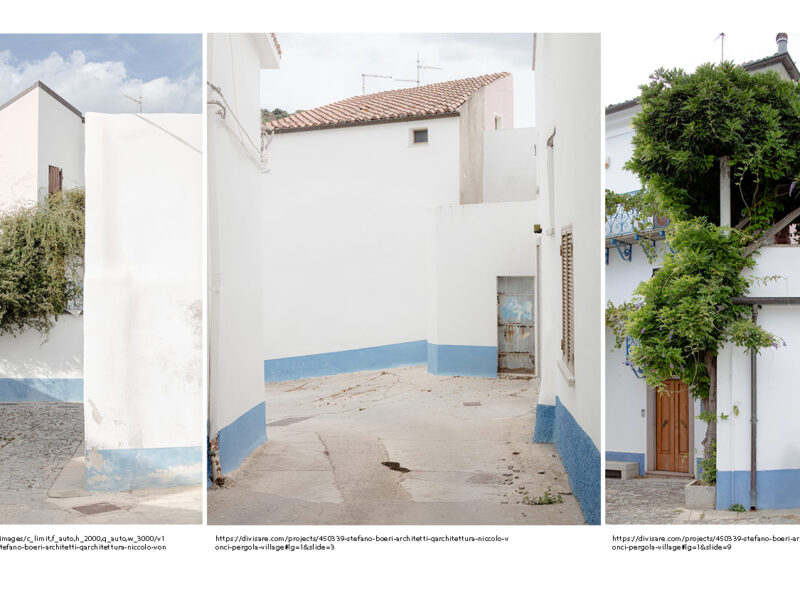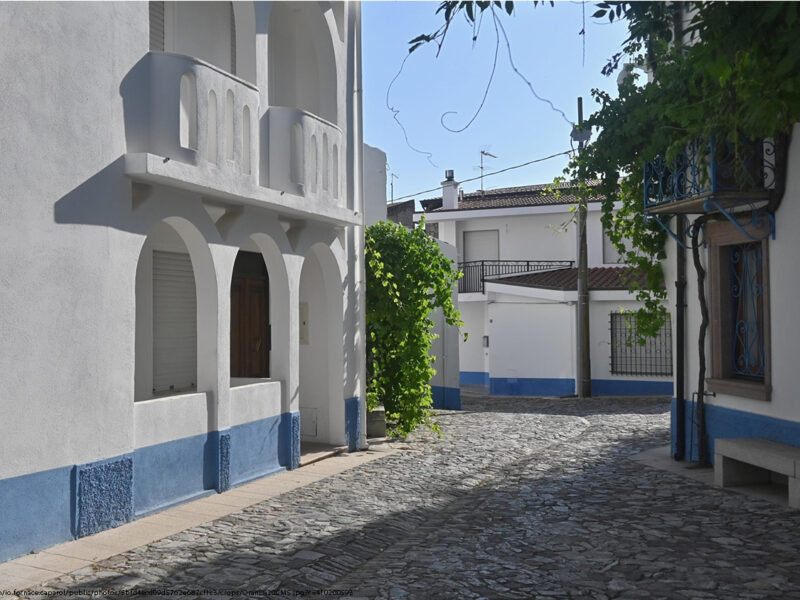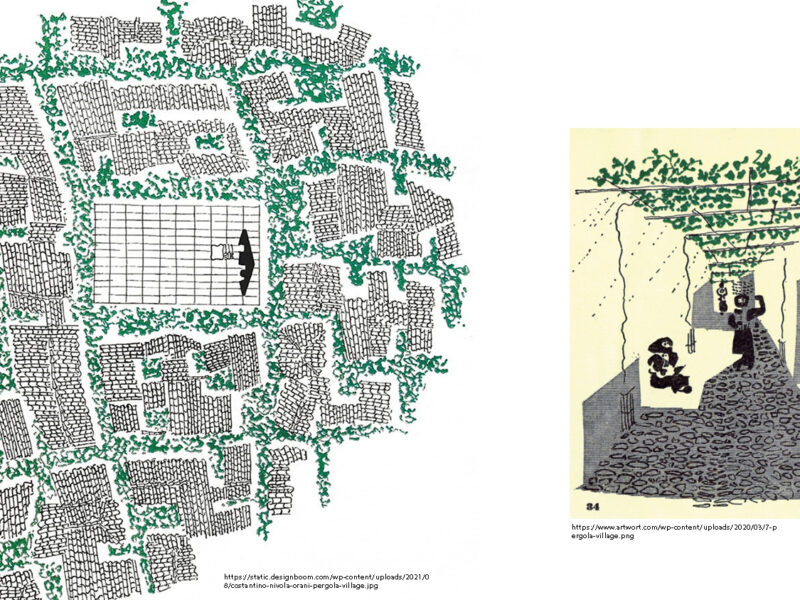Orani Pergola Village






autorský popis projektu
zdroj: https://www.stefanoboeriarchitetti.net/en/project/orani-pergola-village/
Conceived by Costantino Nivola in 1953, the Orani Pergola Village project was born as a work of environmental art intended to strengthen the sense of community of citizens by uniting the houses of the town to each other by means of pergolas, transforming the streets into intimate spaces, liveable collectively by the inhabitants; only the square – adorned with sculptures – was to remain uncovered to emphasize the typical Mediterranean use of a large enclosed room in the city. Blue plinth and green pergolas are both signs intended to highlight and strengthen the social bond between individuals. Like the pergola, the strip of color that was to join the houses together transferred the idea of a cohesive and supportive community on an aesthetic level, capable of making the city a harmonious space for common life. Stefano Boeri Architetti takes up the concept expressed by Nivola in his project, deepening it and bringing it back to light, in a collaboration also implemented with local artisan realities, with the aim of activating the community and principles of inclusion.
The project for Orani is divided into different design options, in relation to the existing urban environment, varying the structure and layout of the pergolas to differentiate the facades and elements that follow one another in the historic center of the small Sardinian town.
The glimpses and plant grafts are emphasized by a careful choice of climbing elements with different chromatic effects – such as wisteria, bougainvillea or vine – in order to emphasize the variation of the colors in relation to the succession of the seasons.
The third option involves an intervention at an intermediate height between the height of the eaves of the lowest building and that of the lowest building, maintaining the same structure as the second type presented; the last option, on the other hand, involves a floor composed of cables and tie rods, which follows the course of the profiles of the houses, thus showing itself straight or inclined, depending on the relationship between the curtains facing each other.
The intervention generates urban interiors made up of existing facades and a fifth façade of living nature that varies with growth and with the seasons, decreasing the “heat island” effect within the streets of the historic center and giving the citizenship of the paths of shadows and lights among the leaves. Within the urban fabric, according to the morphology, the different pergolas can be placed side by side, in a succession of lowered or sloping floors between blossoming flowers and ripe fruit. The choice of vines and plants also takes into account the speed of their growth, in order to generate landscapes that are always renewed and rich in colors and scents. The implementation of the project conceived by Nivola will makes of Orani a splendid example of the regeneration of those Italian villages rich in history, culture and memory, scattered throughout the country, today at risk of being forgotten. Orani Pergola Village shows itself as a discreet intervention, yet able to involve citizens in an international cultural network and to translate the desire to experience collective and outdoor urban spaces into a project.
The realization of the project is intended as a further opportunity to reorganize the mobility and viability of the historical center: the streets of historical and cultural interest, in fact, can be gradually pedestrianized, while the urban voids used as spaces for parking organized for cars. The presence of the pergola and a carefully designed urban furniture – in a system of masonry pots and public seats – allows to create a comfortable and shady environment to make it possible for residents to reach their homes and all services.
studentská recenze projektu
Tereza Brázdová, 01/2023 U6 2022 – Budoucnosti: Čas na změnu
Orani Pergola Village: Úspěšná vize nebo utopie?
V červenci 2021 oživil Stefano Boeri se svým týmem téměř sedmdesát let starou myšlenku italsko-amerického umělce a designéra Constantina Nivoly, na propojení jednotlivých domů v sardinském městečku Orani pomocí pergol porostlých popínavými rostlinami. Hlavní myšlenkou tohoto projektu bylo podle Nivoly přeměnit neosobní uliční prostor v intimní zelené pokoje, které se stanou jevištěm veřejného života místní komunity.
Ačkoli se původně jedná o projekt z 50. let 20. století, je až s podivem, jak hlasitě rezonuje v kontextu dnešní doby. Nabízí překvapivě jednoduché řešení otázky adaptability městského prostředí na změnu klimatu vytvořením mikroklimaticky příjemného urbánního interiéru, který zmírňuje dopady tepelného ostrova, jímž historické jádro Orani – zejména v horkých letních měsících – bezpochyby je.
Podpora veřejného života a posílení sociální soudržnosti už v dnešní postpandemické společnosti nejsou jen prázdnými hesly. Lidé chtějí trávit čas venku, chtějí se společně bavit a pěstovat mezilidské vztahy víc než kdy jindy. Ulice a náměstí krytá živým stropem jim k tomu poskytují prostor. Skvělým nástrojem k posílení komunitního ducha je také participativní realizace celého projektu. Finance rozděluje sardinská nezisková organizace se zaměřením na sociálně-ekonomický rozvoj regionu prostřednictvím individuálních grantů místním obyvatelům. Ti pod vedením uznávaných architektů svépomocí přetvářejí město do podoby, kterou si Nivola mohl jen představovat. Používají k tomu finančně dostupné, lokální materiály – bílé vápno, modrou barvu a vinnou révu.
Tím, co je na výsledné podobě projektu na první pohled nejvíce lákavé, je bezesporu jeho estetika. Modrý sokl a nabílené fasády vizuálně sjednotily a usměrnily urbánní divočinu zástavby. Popnuté pergoly přinášejí do zdánlivě inertního městského prostoru nové vjemy v podobě hry světla a stínu, pohybů listí ve větru, vůní a barev. V krásném prostředí se lidem lépe žije a rádi se do něj vracejí. Boeriho malá intervence by tak mohla mít velký dopad na záchranu tohoto venkovského sídla s bohatou historickou a kulturní tradicí, které – stejně jako množství jemu podobných – čelí ztrátě zájmu jeho obyvatel o své okolí a postupnému vylidňování.
Přispěje tento drobný zásah do městského prostředí k tomu, že lidé opustí pohodlí svých domovů a uliční prostor se stane jejich druhým obývacím pokojem? Stane se Orani inspiračním příkladem pro další podobná, téměř zapomenutá sardinská, potažmo italská, městečka nebo je projekt Orani Pergola Village jen utopistickou myšlenkou s jepičí délkou života? To ukáže až čas.
odkazy a zdroje
odkazy a zdroje
zdroj informací:
zdroj informací:
zdroj informací:
zdroj informací:
https://www.facebook.com/comunediorani/posts/pfbid08EeuuU3y8kQkJ99w2eZn1zTjnZwuNq2QatM3AF9r2pXnM6GiALxDzg4T49TyL576l
zdroj obrazové přílohy 1:
https://studio.mapbox.com/styles/terebra/ckxdec8scerhd14pabpatfuqx/edit/#14.94/40.25147/9.18094
zdroj obrazové přílohy 2:
https://i.cdn-vita.it/blobs/variants/b/3/d/e/b3de2fcd-0a9f-4135-a7f4-274e55108de9_xl.jpg?_637612507472194500
zdroj obrazové přílohy 3:
https://www.stefanoboeriarchitetti.net/wp-content/uploads/2021/10/c-Anastasia-Kucherova_Orani-Pergola-village_Stefano-Boeri-Architetti-5-scaled.jpg
zdroj obrazové přílohy 4a:
https://divisare-res.cloudinary.com/images/c_limit,f_auto,h_2000,q_auto,w_3000/v1636622434/teeutt2ti730o2yi0m10/stefano-boeri-architetti-qarchitettura-niccolo-vonci-pergola-village.jpg
zdroj obrazové přílohy 4b:
https://divisare-res.cloudinary.com/images/c_limit,f_auto,h_2000,q_auto,w_3000/v1636622421/uslcegend98kdydjgqti/stefano-boeri-architetti-qarchitettura-niccolo-vonci-pergola-village.jpg
zdroj obrazové přílohy 4c:
https://divisare-res.cloudinary.com/images/c_limit,f_auto,h_2000,q_auto,w_3000/v1636622437/cgvunylzuaofyfzz8wbt/stefano-boeri-architetti-qarchitettura-niccolo-vonci-pergola-village.jpg
zdroj obrazové přílohy 5:
https://s3-eu-west-1.amazonaws.com/io.fornace.caparol/public/photos/5bfd4ecd09d5762e687cf1c3/crops/OraniCM5.jpg?r=410200593
zdroj obrazové přílohy 6a:
https://static.designboom.com/wp-content/uploads/2021/08/costantino-nivola-orani-pergola-village.jpg
zdroj obrazové přílohy 6b:
https://www.artwort.com/wp-content/uploads/2020/03/7-pergola-village.png
